Parque Mayer turned 100 years old on 15 June 2022!
We celebrated this milestone in the best way possible – by publishing the testimony of someone who knew it intimately. It was, and continues to be, an honour to count on the contribution of our dear friend and collaborator Luís Bayó Veiga, who brings together historical accuracy with the emotions of lived experience. In this chronicle, he shares not only the origins of this unique venue, but also his memories of a place of social gathering, entertainment and culture that, for decades, enlivened the city of Lisbon.
Old-Time Popular Entertainment Venues

Before the emergence of Parque Mayer, people of Lisbon enjoyed themselves at seasonal fairs that offered popular amusements, fairground shows and food and drink stalls.
The annual fairs of Amoreiras, Campo Grande, Luz, Estrela, Lumiar, Santos and Alcântara were typical examples of such events.
But it was above all at the Feira de Agosto (August Fair), which began in 1908 at the Rotunda at the top of the Avenida, and took place throughout the month with free admission, that the popular Lisbon of times past would amuse itself during the long summer days and nights…
It was one of the capital’s main traditional fairs, featuring regional products, snacks, circus-style activities with gymnasts, tightrope walkers, illusionists, acrobats, merry-go-rounds, clowns and many other amusements. A highlight was the “Theatro Júlia Mendes”, a wooden structure brought from the Alcântara Fair, where comic sketches, songs, farces, comedies, revues, magic shows and more were performed — all genres that were much loved by the general public and always drew packed audiences. The Feira de Agosto came to a definitive close a few years after the 5 October 1910 Revolution.
Luna Parque
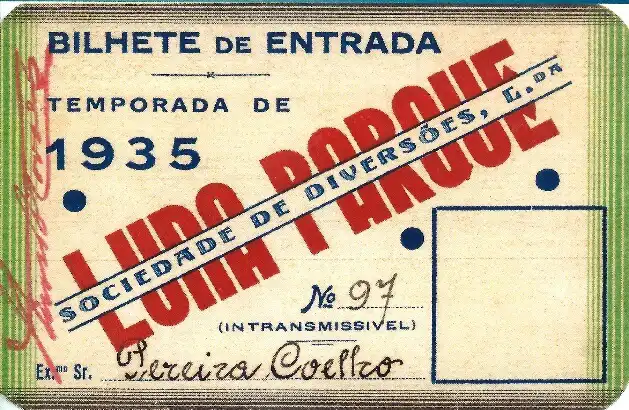
On the right-hand side at the start of Eduardo VII Park, on land adjoining the Portuguese Industrial Exhibition and close to the Rotunda, Luna Parque opened in 1933.
This new Lisbon amusement park was inaugurated on 2 July 1933 and operated by Sociedade de Diversões, Lda, a company formed the previous month.
It offered a set of modern fairground attractions sourced from other international fairs, arriving in Lisbon by sea, fully dismantled.
With paid admission, the park offered the traditional amusements and refreshment stalls, lunch and dinner tents, and new attractions such as a Roller Coaster, Ferris Wheel, Wall of Death, Chinese Maze, Motorised Boats, “Caterpillar Carousel”, Aeroplanes, Ghost Train, Dodgems and many more…
There were also beer halls, cafés, open-air terraces, a large panoramic restaurant-dancehall, and even a fado house called Retiro da Severa, where the most famous fado singers of the time performed. It later moved to the Salão Jansen near the Chiado, retaining the same name, and went on to become legendary.
Although this new venue (which would have a short lifespan, closing just after the summer of 1935) significantly reduced the usual crowds flocking to Parque Mayer for its amusements, the latter continued to draw large audiences to the revue shows held every night — two sessions daily — at the Maria Vitória and Variedades Theatres, or to the film screenings (sometimes also revues) at the Cine-Teatro Capitólio.
Eight years later, the Feira Popular would arrive…
Parque Mayer – Its Origins
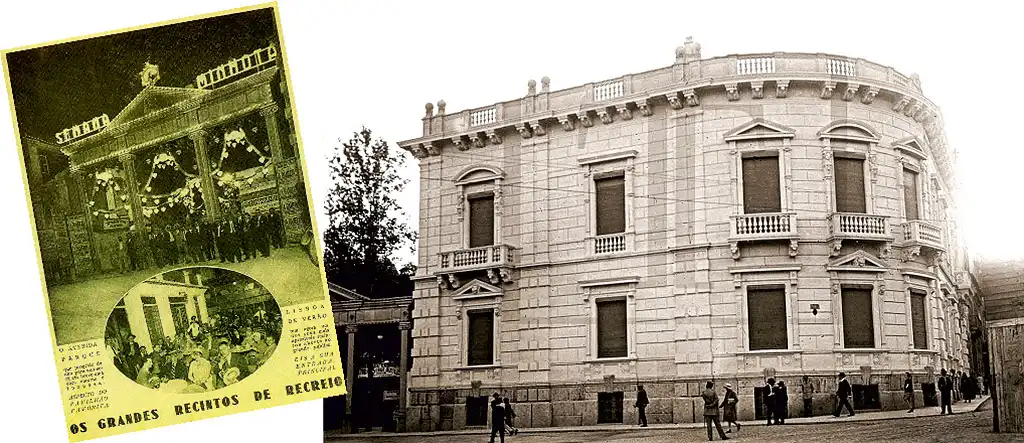
What became known as Parque Mayer was established on the site of the gardens adjoining the Mayer Palace, located on the western side of the Avenida between Rua do Salitre and Praça da Alegria. This property belonged to Adolfo Lima Mayer. Following a division of the estate among the heirs, the palace was put up for auction in 1920 and purchased by financier Artur Brandão, who sold it the following year to the newly formed company Sociedade Avenida Parque, Lda. This company had ten partners, including its majority shareholder Luís Galhardo, a writer, journalist and entrepreneur with strong ties to the theatrical world.
The company’s aim was to acquire a site that could be adapted for social gatherings, entertainment, amusements, and variety shows of all kinds, with particular focus on the popular Teatro de Revista (revue theatre).
The palatial building (designed by architect Nicolau Bigaglia and winner of the 1902 Valmor Prize) had been rented in 1918 by the Mayer family, who turned it into Club Mayer (later known as Avenida Palace Club), similar to other clubs that sprang up across Lisbon in the 1920s. These clubs were devoted to variety shows, dances, dinners, gambling and nocturnal bohemian life, becoming known as “Jazz-Band Clubs”.
In 1930, Sociedade Avenida Parque sold the palace to the Spanish Government, which established there its Consulate General and related services.
Meanwhile, after two years of adaptation works on the gardens and their two lakes, the entire area was transformed into a large leisure space. Various wooden structures were installed to house restaurants and snack bars, amusement games and variety show stages.
The new Lisbon venue was officially inaugurated on 15 June 1922 under the name Avenida Parque, but it quickly became popularly known as Parque Mayer.
A revue theatre was also due to open that same day, but it was only inaugurated two weeks later — the Teatro Maria Vitória, which we will speak about further on. On that first festive day, the main attraction was the Circo Royal, brought especially from Porto, where it was on tour at the time.
The Inauguration of Avenida Parque and the 1920s

Avenida Parque, as a new Lisbon nightlife and leisure venue, offered from the very start establishments for all tastes and preferences — from cafés and taverns to restaurants, retreats, gaming halls, and variety shows, which we will refer to in more detail below.
The first restaurant to open in this new space in 1922, the year of its inauguration, was João Borges.
Still in the 1920s and moving into the following decade, new establishments were added, such as the restaurants Pavilhão Branco and Castelo dos Mouros, and snack bars like Gruta do Lagarto, O Cantinho dos Bons Amigos, and Valente das Farturas, among others.
As for variety entertainment, music, and fado venues, from the very opening of Avenida Parque came the Esplanada Egípcia, followed two years later in 1924 by the Pavilhão Português, and then in 1925 by the Alhambra — all three featuring open-air terraces. These spots were particularly popular at weekends and often packed to capacity.
These establishments operated only during the spring and summer seasons.

At a time when electric lighting had not yet reached every home in Lisbon, Parque Mayer stood out as a space filled with light — and later with colourful neon signs — which would come to define it as an iconic hub of popular attraction.
Also in this decade, in 1926, the second revue theatre opened: Teatro Variedades, which we will discuss later in this article.
By the late 1920s, some of the Parque Mayer facilities were already showing signs of wear, due to the temporary nature of their original wooden construction. The entire area required upgrades to its infrastructure as well as a visual refresh.
The Sociedade Avenida Parque invited architect Luís Cristino da Silva to redesign the venue’s entrance, which until then had consisted of a wooden structure resting on four pillars and forming three large rectangular arches. His design resulted in a new entrance, inaugurated in 1930, made up of two pairs of tall columns adorned with various bas-relief motifs and topped by a series of lanterns set in a cascading glass and iron frame, illuminated at night in the Art Deco style.
The 1930s and 1940s
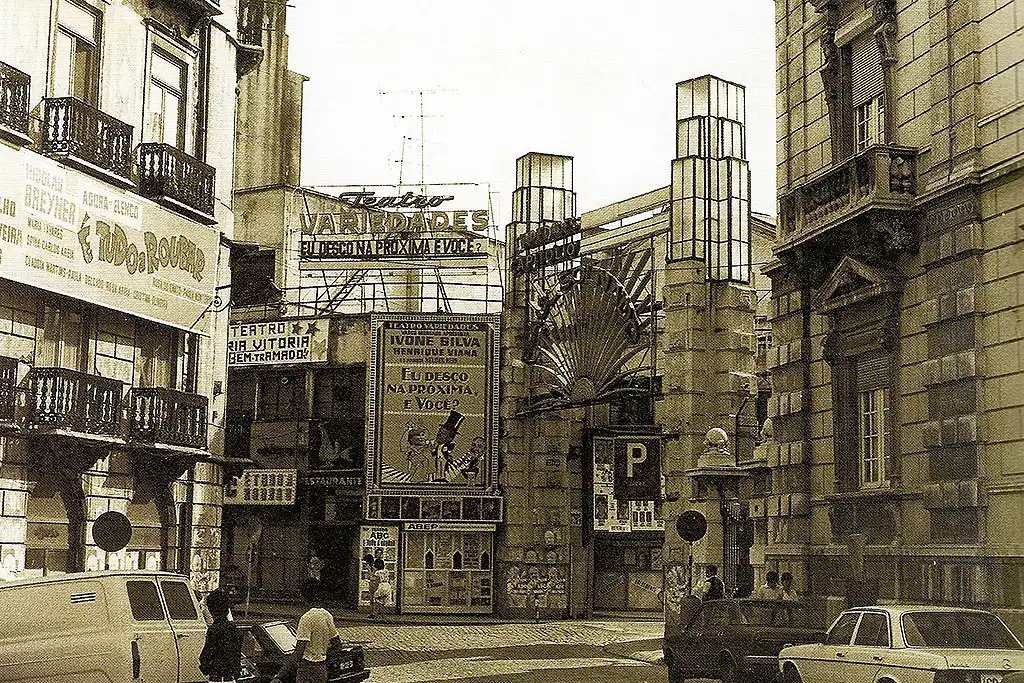
At the beginning of the 1930s, maintenance and new construction works began, this time using masonry, to build small buildings for shops and housing on the upper floor.
From this point onward, the popular name Parque Mayer finally prevailed over the original Avenida Parque, which had been in use since the site’s opening.
Cristino da Silva was once again called upon, this time to design a new theatre, which resulted in the Cine-Teatro Capitólio, inaugurated in 1931. It was built on the site previously occupied by the Esplanada Egípcia, mentioned earlier.
In 1937, on the site where the Estádio Mayer would later be built, the temporary Teatro Recreio was erected. It premiered on a stormy night with the revue Faça Sol (let it be sunny). Its entrepreneur was Giuseppe Bastos, but the theatre lasted only a short time, closing in 1940 to make way for a boxing ring.
The First Stage of Lisbon’s Popular Marches
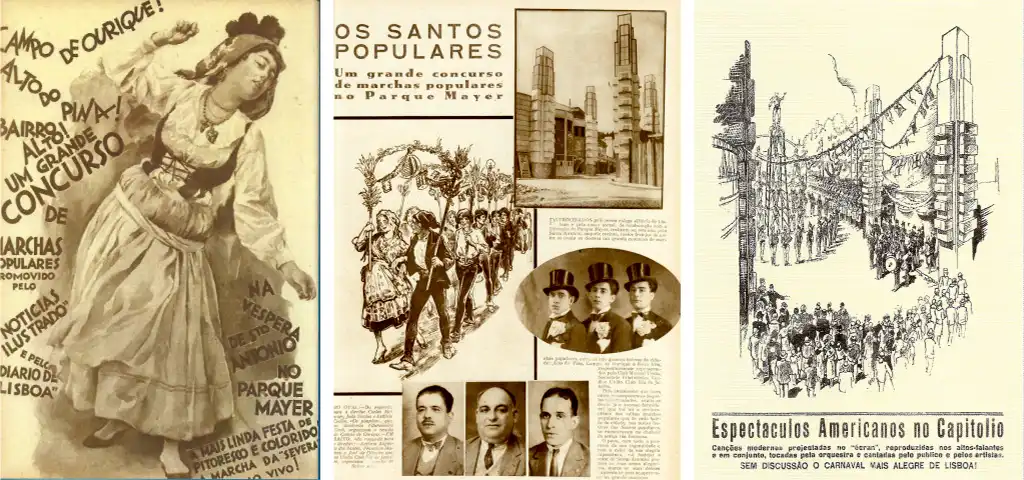
In June 1932, on the initiative of Diário de Lisboa and Notícias Ilustrado, and following a suggestion by Leitão de Barros with support from Norberto Araújo — both well-known figures in cinema and journalism — Parque Mayer hosted the very first edition of the Lisbon Popular Marches competition. Only three “ranchos” (as they were then called) took part: Bairro Alto, Campo de Ourique, and Alto do Pina. Parque Mayer proved too small for the enthusiasm it attracted!
Three other neighbourhoods — Alfama, Alcântara, and Madragoa — were invited to participate as non-competing guests.
Lisbon City Council soon expressed interest in supporting the initiative, which became official in 1935 when the marches were included for the first time in the city’s annual festivities programme, with 12 neighbourhoods taking part.
The Amusements
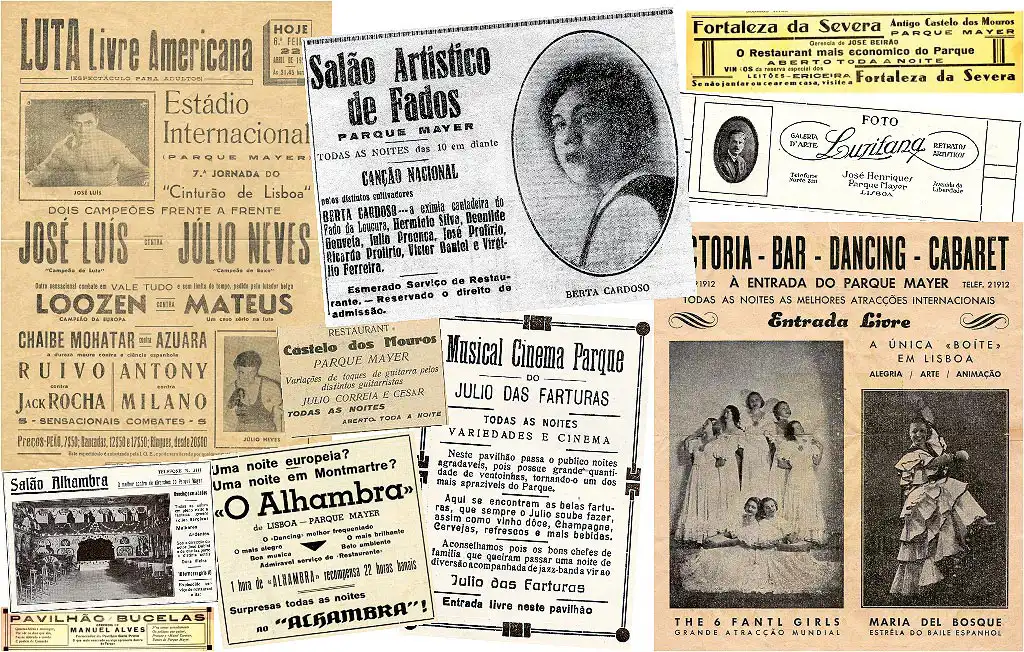
In the 1930s and in the years that followed, Parque Mayer offered a wide and diverse range of amusements: target shooting stalls, the Pim! Pam! Pum!, various raffles involving tossing rings onto bottle necks or packs of cigarettes, the “diabolical roulette”, and lucky dips where there was always a prize…
There were also illegal gambling tables hidden in the more secluded corners of the park.
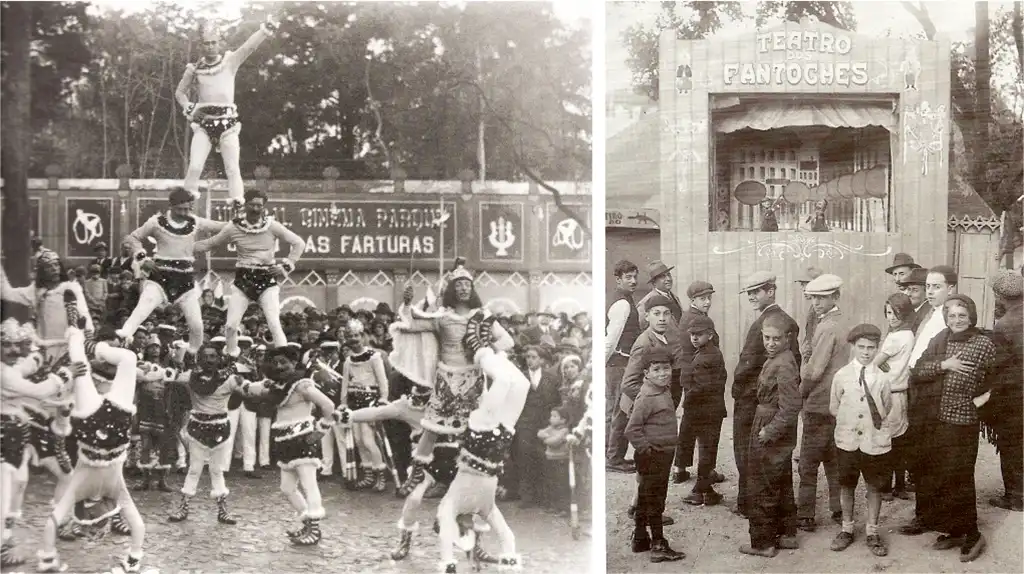
On festive occasions and throughout the summer months, open-air dances were held, specially to celebrate the Santos Populares and the carnival season, the highlight of which was the Dança da Luta (Dance of the Fight).
Also during the 1930s and early 1940s, summer circus shows were held — such as Royal, El Dorado, and Luftman.
There were also the so-called “freak shows”, which showcased alleged human anomalies such as the transparent woman, the electric woman, and the mermaid woman, all of which attracted large crowds of curious visitors.
As for restaurants, retreats, and eateries operating throughout the 1930s and 1940s, these included: O Amaral, A Favorita, O João Borges, A Portuguesa, Retiro Amadora, Júlio das Miombas, A Mina (Júlio das Farturas), A Transmontana, and Retiro Amadora.
Still on the topic of amusements, in the early 1940s, skating rinks and bumper cars also began drawing large crowds.
In 1942, Casablanca opened — a venue for entertainment and leisure activities where numerous boxing matches were held until the end of the decade. It was located where the Alhambra had stood in the 1920s, later replaced by Galo de Oiro and then Baía, all of which were dedicated to entertainment, dancing, and variety shows.
The Estádio Mayer

At the beginning of the 1940s, on the site where the Teatro Recreio once stood, the Estádio Mayer (Mayer stadium) was built. It would later change its name to Estádio Internacional in 1949.
It was in this new indoor venue that, on weekends, handball and basketball matches were held, but above all, boxing matches in a specially mounted ring, drawing delirious crowds who came to cheer on their heroes.
Among the boxers who rose to fame at the Estádio Mayer were Belarmino Fragoso, Chico Santos, and Carlos Rocha, among other renowned names of the time.
In 1956, the much-anticipated boxing match between the two greatest boxers of the day—Belarmino Fragoso and Chico Santos—took place at the Estádio Internacional. Both represented the Grupo Desportivo da Mouraria, with the latter winning on points. The venue was sold out, and large crowds gathered outside to listen to the live broadcast of the famous bout.
However, it was the unforgettable wrestling matches held during the summer seasons that attracted the largest audiences!
Prominent figures in this sport included wrestlers with stage names such as Jack Rocha, El Moreno, Loosen, Saludes, Júlio Neves, Kid Max, and, reportedly in the 1960s, the greatest of them all, Tarzan Taborda—an idol among enthusiasts of the genre.
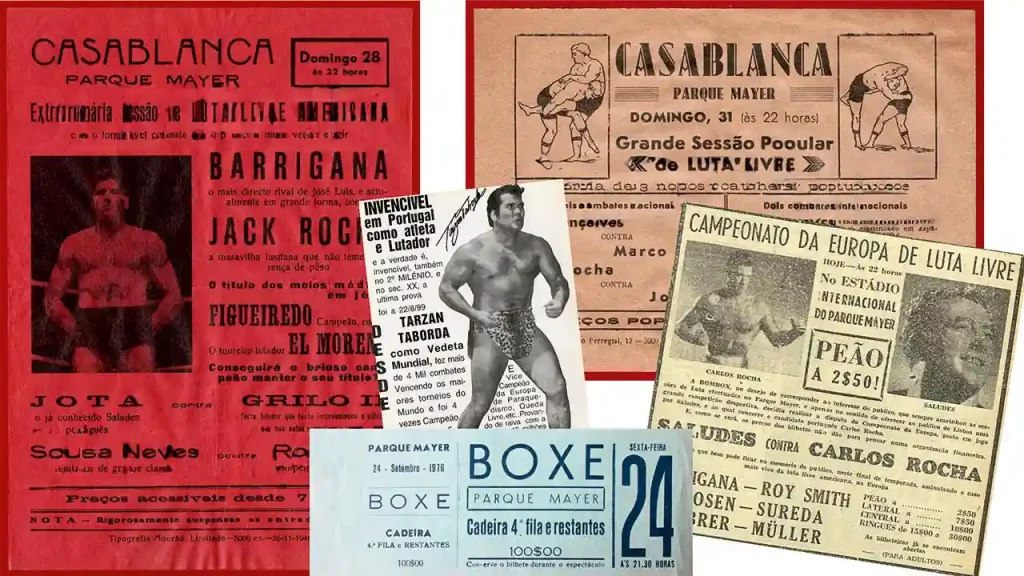
These boxing and wrestling events continued throughout the 1950s—their golden age—until the venue was dismantled in the mid-1960s and turned into a car park. In the early 1970s, matches resumed in a ring set up for the purpose, until they came to a definitive end in 1982.
The Feira Popular de Lisboa
Meanwhile, on 10 June 1943, the Feira Popular de Lisboa (Lisbon Funfair) was inaugurated. In its early years, it was located in the José Maria Eugénio Park in Palhavã, where it remained for several years before moving to Entrecampos in 1956.
With the opening of the Feira Popular—held annually from May to September—this new entertainment venue, aimed at children and families, offered a wide variety of amusements and dining options, along with many other features. It soon began to attract a growing number of visitors. In the meantime, although the Parque Mayer maintained a full and vibrant daily programme with up to three revues (sometimes even four), it started to see a visible decline in footfall, particularly among regular patrons of its amusements and restaurants.
The 1950s and 60s
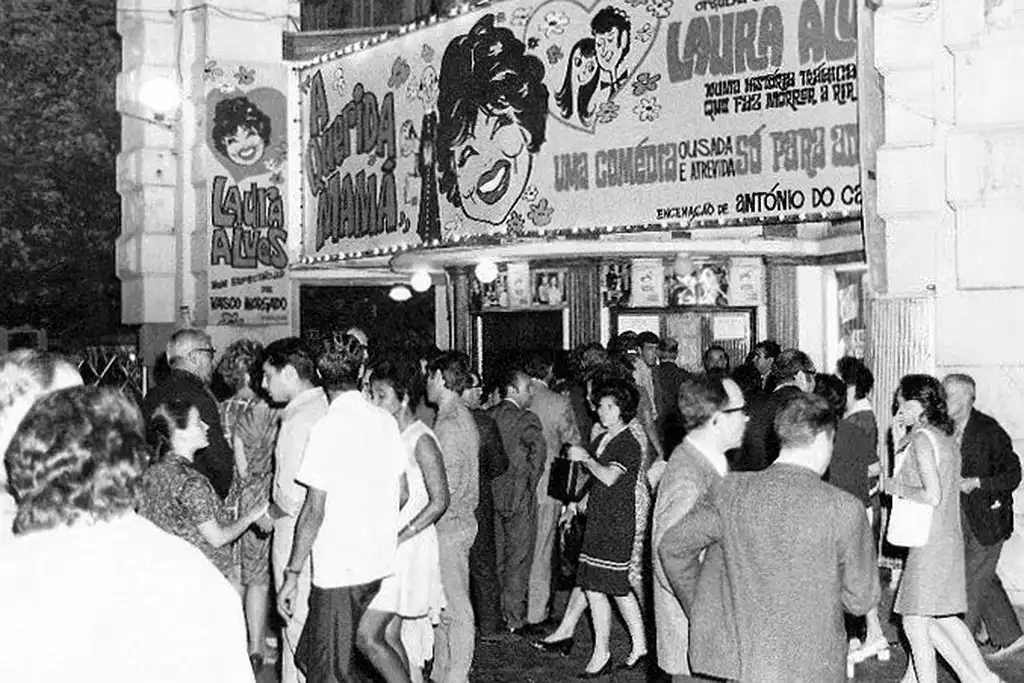
In an effort to counteract the impact of the Feira Popular in Palhavã on visitor numbers during the summer months, Parque Mayer sought to diversify its entertainment offerings. New amusement spaces opened, including games rooms (for table tennis, table football, mini-car tracks, darts, and billiards), a carousel with wooden horses, and others.
Small kiosks began to appear selling ice creams (Iglô, Esquimaux, Rajá) as well as chocolates and sweets. Particularly memorable were the “furo” prize boxes from Regina—depending on the colour of the ball (one of seven), the customer would receive a chocolate of corresponding size. The golden ball meant you’d take home “kilos of chocolate”…
Thus, during these two decades, Parque Mayer would turn into a mini funfair in the summer months.
The Restaurants
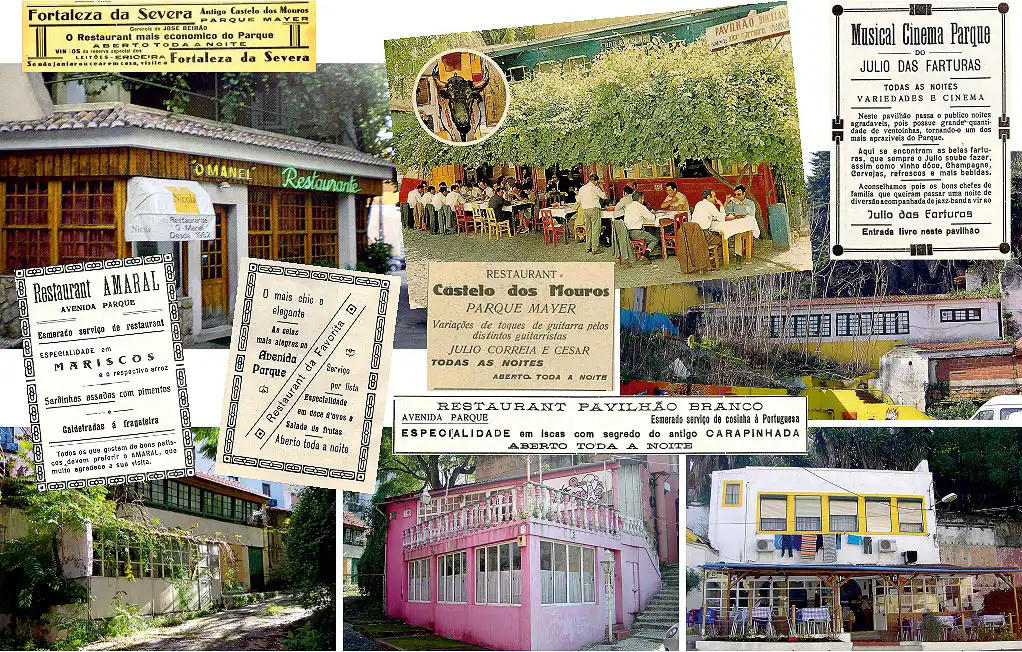
Over time, several establishments were either converted into restaurants, renovated, or rebuilt altogether.
Most adopted a new look, new management, and new names. By the 1950s, more than a dozen restaurants were fully operational and open to the public.
Among the most popular were: Gato Preto (later renamed Tricas), Júlio das Miombas (also known as Malcriada and Varina, which eventually became A Gina in 1974), Pavilhão de Bucelas (run by Xico Carreira), Manecas, Manel, and Retiro da Amadora—commonly referred to as Mimi’s restaurant, in reference to one of the three sisters, Maria da Ascensão, who was affectionately known by that nickname. Altogether, up to 13 restaurants were operating simultaneously in Parque Mayer.
With the growing popularity of fado and its recognition as the national song, restaurants that hosted musical and variety performances began to feature fado sessions more frequently. Notable examples include the Salão Artístico de Fados (since 1934), Fortaleza da Severa (formerly Castelo dos Mouros in 1932), A Mina (Júlio das Farturas), the Sala Júlia Mendes (from 1950), as well as Pavilhão Português and Alhambra, which offered memorable fado nights during the warm summer evenings—always drawing large crowds of fado lovers.
The Charms and Hidden Corners

Among the many charms and hidden corners of Parque Mayer, one remembers the photography studios Foto Luzitana and Foto Parque, the Guarda-Roupa Paiva (which dressed generations of stage stars since the founding of Parque Mayer and survived until mid-2009), the Salão Artístico hair salon, the bookstall of second-hand bookseller Anselmo, and the kiosks where Dona Rosa sold capilé and Dona Adélia (known as “Adélia dos Pirolitos”) sold pirolitos (a gas drink).
Also popular were the bars, dance halls, and cabarets: Arcádia (1944), Victória Dancing (1952), Cantinho dos Artistas (1962), and Dominó (1990). These venues offered musical and variety shows and were much frequented by lovers of the cabaret atmosphere, night-time nostalgia, and those who sought a more intimate experience.
The Revue Theatres of Parque Mayer
Parque Mayer became especially famous for its theatres, where the best and most iconic revista shows—Portuguese-style revues—have been performed up to the present day.
From the very beginning, the Sociedade Avenida Parque, as it set about converting the gardens of the Mayer Palace into a leisure and entertainment venue, firmly intended to build a purpose-built theatre—solid and permanent, unlike the temporary, easily dismantled theatres typically found at funfairs. Luís Galhardo pushed this idea forward, and after some delays, just fifteen days after the public opening of the new amusement park, the first theatre within the complex was inaugurated: the Teatro Maria Vitória, opened on Saturday, 1 July 1922, in provisional wooden facilities.
Maria Vitória
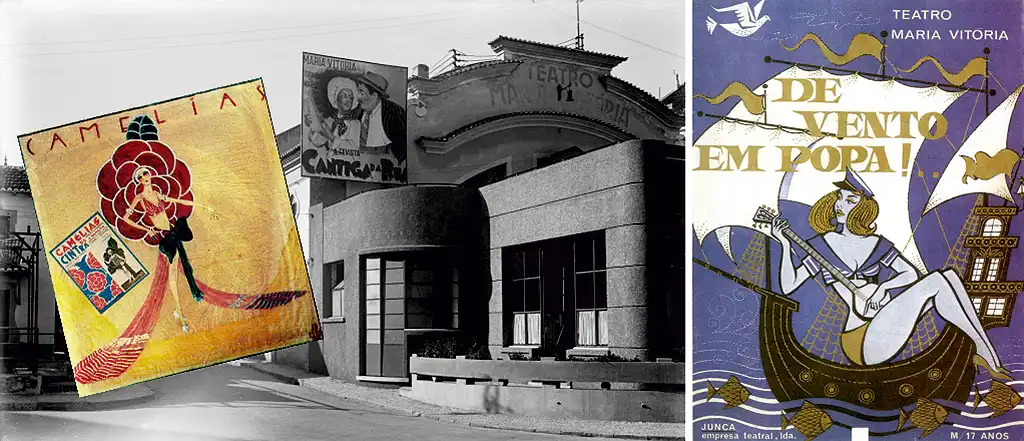
The name of this theatre pays tribute to the memory of the famous actress and fado singer Maria Victoria, whose untimely death at the age of 26 had, only a few years earlier, deeply moved the people of Lisbon. This wooden structure, popularly nicknamed the Teatro do Pau (“Wooden Theatre”), was later replaced by a masonry building.
The first revue performed there was Lua Nova (New Moon), written by Ernesto Rodrigues, Henrique Roldão, Félix Bermudes and João Bastos, featuring musical numbers by Maestro Raul Portela and musical direction by Maestro Alves Coelho. The cast included Elisa Santos, Amélia Perry, Jorge Roldão and Joaquim de Oliveira.
At first, with only one covered revue theatre in operation, other venues were gradually set up over the following years, occasionally hosting theatrical performances as well as various open-air variety and musical shows, such as those held at the Esplanada Egípcia and the Pavilhão Português.
Variedades
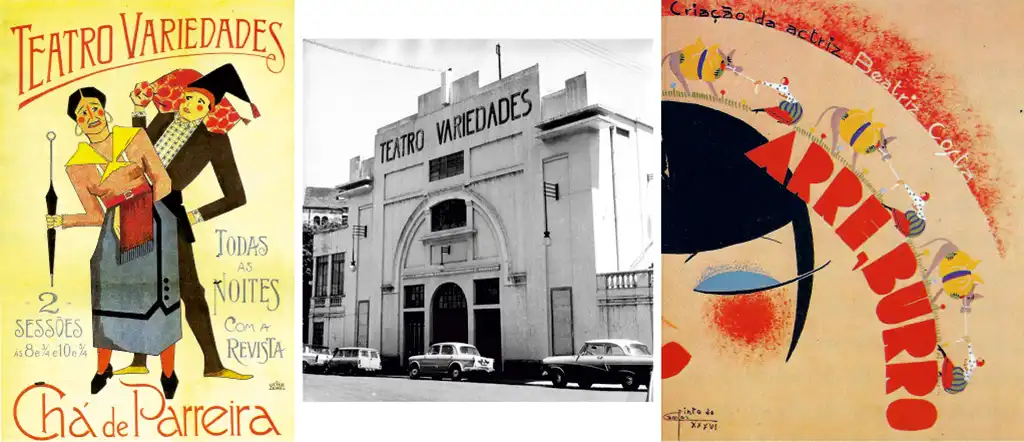
The Teatro Variedades, designed by Urbano de Castro, was built on the grounds where a lake once existed in the gardens of the Mayer Palace.
It was inaugurated on 8 July 1926 with the revue Pó de Arroz, directed by Rosa Mateus, written by Ernesto Rodrigues, Luís Galhardo and others, and featuring a cast that included Vasco Santana as the headliner and Augusto Costa (known as Costinha) as compère, among others.
Capitólio

The Cine-Teatro Capitólio was inaugurated on 10 July 1931. It was built on the site where the Esplanada Egípcia once stood. The project was designed by architect Luís Cristino da Silva.
It was initially used as a cinema, and only later began to host other performances such as musical and variety shows, including revues and other genres, in the style of the cine-theatres of the time.
It was a pioneer in many innovations in Portugal. It featured a moving walkway— the first in the country— that led to a rooftop terrace where, during the summer months, open-air cinema screenings were held. At one point, there was even an ice-skating rink on the premises.
ABC
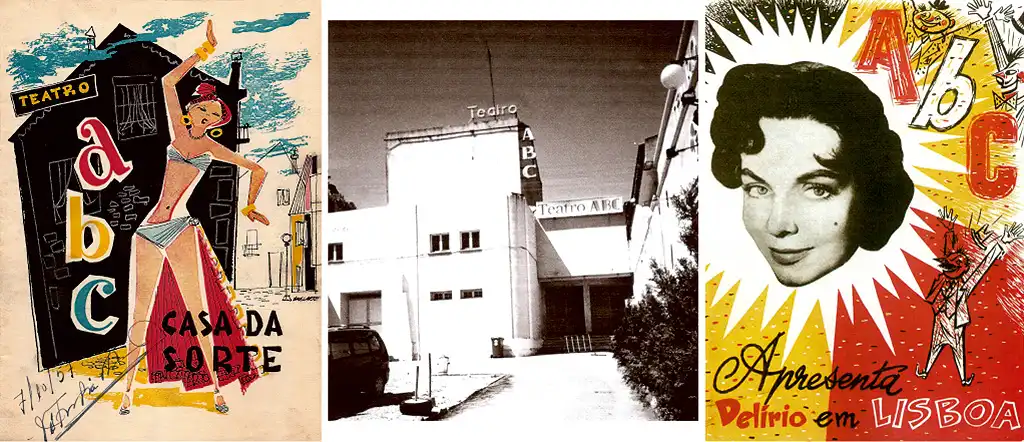
Lastly, Teatro ABC was the final venue to be inaugurated at Parque Mayer.
Its construction required the demolition of the Pavilhão Casablanca and a side section of the Pavilhão Português, which, after being repurposed, lasted a few more years until the 1970s. It then fell into decline, eventually showing cheap films aimed at youngsters, far removed from the glory of the “good old days”…
It opened its doors on 13 January 1956 with the revue Haja Saúde, written by Frederico de Brito and Carlos Lopes, starring Curado Ribeiro and Maria Domingas. The theatre’s impresario was José Miguel.
After the 25 April 1974 Revolution, this theatre hosted erotic shows such as the famous Isto é Crazy Horse, produced by Sérgio de Azevedo, ABC’s theatrical entrepreneur. It was demolished in January 2015 to make way for yet another car park…
So Many Contributed to the Success of the Teatro de Revista at Parque Mayer…
Parque Mayer became the hub of Portuguese-style revues, even though other Lisbon theatres also staged this type of show. Teatro Maria Vitória itself came to be known as the “cathedral of Teatro de Revista”.
It enjoyed its Golden Age from the 1930s to the 1970s, after which it went into decline. There were two performances on weekdays, including Saturdays. On Sundays and public holidays, matinées were also held.
Countless artists performed on the stages of Parque Mayer‘s theatres, bringing audiences moments of joy and amazement—not only through the characters they portrayed but also due to their undeniable talent and professionalism.
Among the many revues the author of these lines attended between the 1960s and 1980s, I would like to pay tribute by recalling some of the stars (among many others) I had the pleasure of knowing and seeing on stage. These leading performers are etched in the memories of the thousands upon thousands who watched countless shows at Parque Mayer:
Carlos Leal, Leónia Mendes, Eugénio Salvador, Camilo de Oliveira, Io Apolloni, José Viana, Dora Leal, Mariema, Octávio de Matos, Victor Mendes, Barroso Lopes, Henrique Santana, Raul Solnado, Florbela Queirós, Carlos Miguel, Nicolau Breyner, Carlos Cunha, Marina Mota, Natalina José, Ivone Silva, José Raposo, João Baião, Vera Mónica…
They were joined by authors, musicians, lighting technicians, production staff, carpenters, seamstresses, and impresarios such as Giuseppe Bastos, Vasco Morgado and Vasco Morgado Júnior, Eugénio Salvador, José Miguel, Sérgio de Azevedo, and more recently, Hélder Freire Costa. Together, they made possible many of the great successes that marked this genre of theatre and the popular music of the second half of the 20th century, continuing to this day.
Also worth remembering, with due homage, is the painter, model-maker, set and costume designer Mário Alberto, who, from 1973 onwards, lived at the Parque, where he had his studio. He was one of Parque Mayer’s last residents. Throughout his life, he lived among artists and theatre professionals and was the creator of countless costume sketches, models and posters for many of the revues that became great hits in their time.
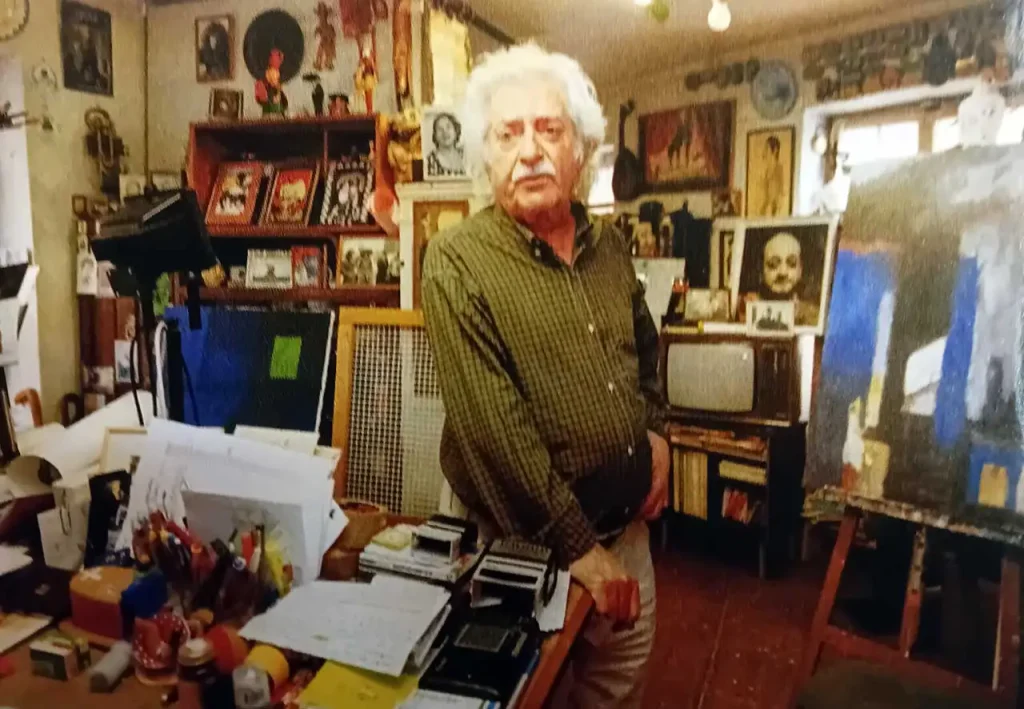
Today, apart from the restaurant A Gina, only the renovated Capitólio and rebuilt Variedades remain, along with Teatro Maria Vitória—the only theatre still presenting Portuguese-style revues. It continues to operate uninterruptedly within Parque Mayer, thanks to the perseverance of its impresario and producer, Hélder Freire Costa, who has run the venue since 1975.
The Unforgettable Songs That Premiered in Teatro de Revista and Were Later Sung Across the Streets of Lisbon
It was common for revues to feature a national singing star who would debut an original revista song during the performance. These songs were often linked to a particular scene or the overall theme of the revue and immediately captivated the audience.
Some of these songs became hugely popular hits, sung or whistled throughout Lisbon—especially at a time when whistling was in vogue.
Of the more than 360 revues staged at Parque Mayer between its opening and the present day (1922–2024), many featured songs that became massive hits and are still remembered today.
I recall here some of the unforgettable songs I witnessed and heard live:
A Rua os meus Ciúmes / Helena Tavares – Revista “A Vida é Bela” (1960)
O Fado mora em Lisboa / Mariema – Revista “Sopa no Mel” (1965)
Ó Tempo volta p’ra trás / António Mourão – Revista “E Viva o Velho” (1965)
Zé Cacilheiro / José Viana – Revista “Zero, Zero Zé – Ordem p’ra Pagar” (1966)
Lisboa da cor da ponte / Beatriz da Conceição – Revista Mini-Saias (1966)
O que sobrou da Mouraria / Tony de Matos – Revista “Arroz de Miúdas” (1968)
Cheira a Lisboa / Anita Guerreiro – Revista “Peço a Palavra” (1969)
Maria Zaragateira / Leónida Mendes – Revista “Oh Pá Pega na Vassoura” (1974; Música de 1960)
A Brief Epilogue
Parque Mayer…
A place of magic, the Broadway of the people of Lisbon, the capital of revista à portuguesa (Portuguese-style revues), a site of gallant escapades, picturesque episodes, hidden romances, a bohemian centre, the city’s most important gathering spot—where theatre legends, Lisbon residents and notable figures of their time came together in a festive atmosphere of entertainment, cuisine and popular culture… all of it has come to an end.
Yet, the story of Parque Mayer will forever remain entwined with the political, social and cultural journey of the country.
| Never miss another article | Subscribe here |
Also read
– The Area of Cais do Sodré, Origin and Experiences
– A Brief History of Tagus Estuary Boats
– The Elegant Chiado of the Glove Shops
by this author.
Bibliography:
- ACCIAIUOLI, Margarida, Os Cinemas de Lisboa – Um Fenómeno Urbano do Século XX, 2012
- ARAÚJO, Norberto, Peregrinações em Lisboa. vol. XIV, Lisboa: Ed. Vega, 1993
- DIAS, Marina Tavares, Lisboa Desaparecida, vol. 9, Quimera Editores Lda., Lisboa, 2007
- FERNANDES, José Manuel, Cinemas de Portugal, 1995
- NEGRÃO, Albano Zink, O Parque Mayer: Cinquenta Anos de Vida, Lisboa, Editorial Notícias, 1965
- RIBEIRO, M. Félix, Os Mais Antigos Cinemas de Lisboa, 1978
- REBELLO, Luiz Francisco:
História do Teatro de Revista em Portugal. Vol.I, Lisboa, Publicações Dom Quixote, 1984
História do Teatro de Revista em Portugal. Vol.II, Lisboa, Publicações Dom Quixote, 1985 - SANTOS, Vítor Pavão, A Revista à Portuguesa: Uma História Breve do Teatro de Revista. Lisboa, O Jornal, 1978
- TRIGO, Jorge / REIS, Luciano:
Parque Mayer (1922/1952) vol. I, Lisboa, Sete Caminhos, 2004
Parque Mayer (1953/1973) vol. II, Lisboa, Sete Caminhos, 2005
Parque Mayer (1974/1994) vol. III, Lisboa, Sete Caminhos, 2006 - VIEIRA, Joaquim, Portugal século XX: Crónica em imagens 1920-1930, Lisboa, Círculo de Leitores, 1999
- Online / Blogs: Almanak Silva; Restos de Colecção

Luís Bayó Veiga
Curious and Lisbon lover, where he was born in 1948. Lives in Almada.
Collector of old Portuguese Comics and Illustrated Postcards about Lisbon, with thousands of items in his collections. He also has a significant collection of books, newspapers, magazines and supplements relating to the city.
Author of some books on memories and local history of Cacilhas and Almada. Co-author of more than a dozen documentaries on aspects of old Lisbon in multimedia support.
Member of the Grupo dos Amigos de Lisboa.
Assiduous attendee of conferences, colloquiums and others, organised by several public and private entities, in the scope of Lisbon studies.
Has a degree in Chemical Engineering from IST and two post-graduates from ISCTE.




